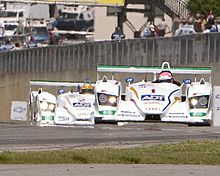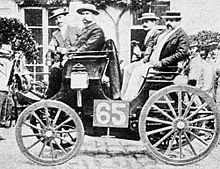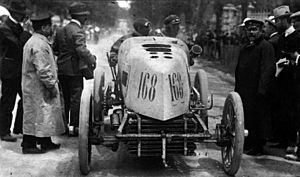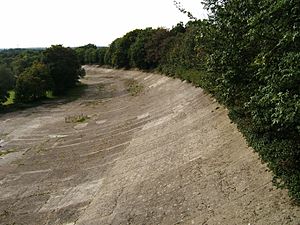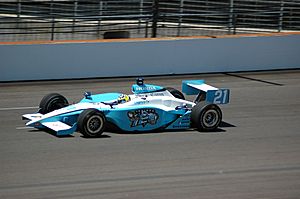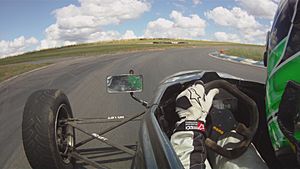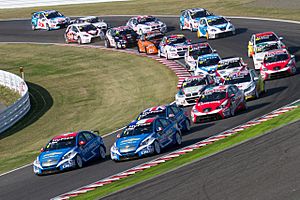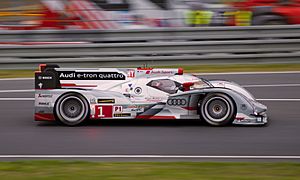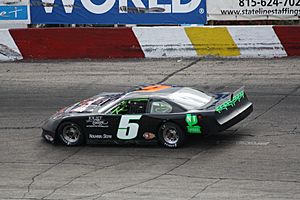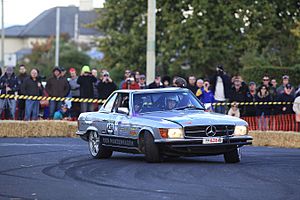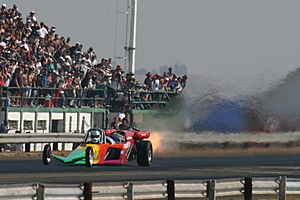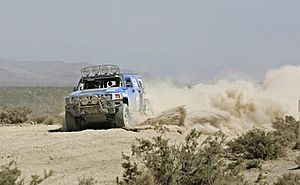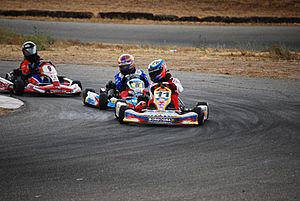Auto racing facts for kids
Auto racing (also known as automobile racing, autosport or motorsport) is a sport involving racing automobiles. Auto racing began in France in 1895 and is now one of the world's most popular spectator sports.
Contents
History
The first prearranged match race of two self-powered road vehicles over a prescribed route occurred at 4:30 A.M. on August 30, 1867, between Ashton-under-Lyne and Old Trafford, a distance of eight miles. It was won by the carriage of Isaac Watt Boulton.
Internal combustion auto racing events began soon after the construction of the first successful gasoline-fueled automobiles. The first organized contest was on April 28, 1887, by the chief editor of Paris publication Le Vélocipède, Monsieur Fossier. It ran 2 kilometres (1.2 mi) from Neuilly Bridge to the Bois de Boulogne.
On July 22, 1894, the Parisian magazine Le Petit Journal organized what is considered to be the world's first motoring competition, from Paris to Rouen. One hundred and two competitors paid a 10-franc entrance fee.
The first American automobile race is generally held to be the Thanksgiving Day Chicago Times-Herald race of November 28, 1895. Press coverage of the event first aroused significant American interest in the automobile.
With auto construction and racing dominated by France, the French automobile club ACF staged a number of major international races, usually from or to Paris, connecting with another major city, in France or elsewhere in Europe.
Brooklands, in Surrey, was the first purpose-built motor racing venue, opening in June 1907. It featured a 4.43 km (2.75 mi) concrete track with high-speed banked corners.
One of the oldest existing purpose-built automobile racing circuits in the United States, still in use, is the 2.5-mile-long (4.0 km) Indianapolis Motor Speedway in Speedway, Indiana. It is the largest capacity sports venue of any variety worldwide, with a top capacity of some 257,000+ seated spectators.
NASCAR was founded by Bill France, Sr. on February 21, 1948, with the help of several other drivers of the time. The first NASCAR "Strictly Stock" race ever was held on June 19, 1949, at Daytona Beach, Florida.
From 1962, sports cars temporarily took a back seat to GT cars, with the FIA replacing the World Championship for Sports Cars with the International Championship for GT Manufacturers.
From 1972 through 2003, NASCAR's premier series was called the Winston Cup Series, sponsored by R. J. Reynolds Tobacco Company cigarette brand Winston. The changes that resulted from RJR's involvement, as well as the reduction of the schedule from 48 to 31 races a year, established 1972 as the beginning of NASCAR's "modern era".
The IMSA GT Series evolved into the American Le Mans Series, which ran its first season in 1999. The European races eventually became the closely related Le Mans Series, both of which mix prototypes and GTs.
Turismo Carretera (Road racing, lit., Road Touring) is a popular touring car racing series in Argentina, and the oldest car racing series still active in the world. The first TC competition took place in 1937 with 12 races, each in a different province. Future Formula One star Juan Manuel Fangio (Chevrolet) won the 1940 and 1941 editions of the TC. It was during this time that the series' Chevrolet-Ford rivalry began, with Ford acquiring most of its historical victories.
Categories
Open-wheel racing
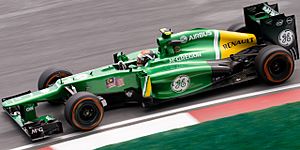
The two most popular varieties of open wheel racing are Formula One and the IndyCar Series.
Formula One is a European-based series that runs only street and road courses. These cars are very technologically advanced, and are very fast through turns. These cars can go 375 kph (233 mph). Some of the famous races they run are the Monaco Grand Prix, the Italian Grand Prix, and the British Grand Prix. The season ends with the crowning of the World Championship for drivers and constructors.
In single-seater (open-wheel), the wheels are not covered, and the cars often have aerofoil wings front and rear to produce downforce and enhance adhesion to the track. In Europe and Asia, open-wheeled racing is commonly referred to as "Formula", with appropriate hierarchical suffixes. In North America, the "Formula" terminology is not followed (with the exception of F1). The sport is usually arranged to follow an international format (such as F1), a regional format (such as the Formula 3 Euro Series), and/or a domestic, or country-specific, format (such as the German Formula 3 championship, or the British Formula Ford).
In the Americas, the most popular series is the National Championship, more commonly known as the IndyCar Series and previously known as CART). The cars have traditionally been similar though less technologically sophisticated than F1 cars, with more restrictions on technology aimed at controlling costs. While these cars are not as technologically advanced, they are faster, being able to average a lap at 388 kph (241 mph). The series' biggest race is the Indianapolis 500, which is commonly referred to as "The Greatest Spectacle in Racing" due to being the longest continuously run race and having the largest crowd for a single-day sporting event (350,000+).
The other major international single-seater racing series is GP2 (formerly known as Formula 3000 and Formula Two). Regional series include Formula Nippon and Formula V6 Asia (specifically in Asia), Formula Renault 3.5 (also known as the World Series by Renault, succession series of World Series by Nissan), Formula Three, Formula Palmer Audi and Formula Atlantic. In 2009, the FIA Formula Two Championship brought about the revival of the F2 series. Domestic, or country-specific, series include Formula Three and Formula Renault, with the leading introductory series being Formula Ford.
Single-seater racing is not limited merely to professional teams and drivers. There exist many amateur racing clubs. In the UK, the major club series are the Monoposto Racing Club, BRSCC F3 (Formerly ClubF3, formerly ARP F3), Formula Vee and Club Formula Ford. Each series caters for a section of the market, with some primarily providing low-cost racing, while others aim for an authentic experience using the same regulations as the professional series (BRSCC F3).
There are other categories of single-seater racing, including kart racing, which employs a small, low-cost machine on small tracks. Many of the current top drivers began their careers in karts. Formula Ford represents the most popular first open-wheel category for up-and-coming drivers stepping up from karts. The series is still the preferred option, as it has introduced an aero package and slicks, allowing the junior drivers to gain experience in a race car with dynamics closer F1. The Star Mazda Series is another entry-level series.
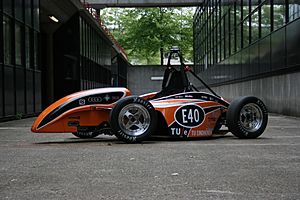
Students at colleges and universities can also take part in single-seater racing through the Formula SAE competition, which involves designing and building a single-seater car in a multidisciplinary team and racing it at the competition. This also develops other soft skills, such as teamwork, while promoting motorsport and engineering.
The world's first all-female Formula racing team was created in 2006. The group was an assemblage of drivers from different racing disciplines and formed for an MTV reality pilot, which was shot at Mazda Raceway Laguna Seca.
In December 2005, the FIA gave approval to Superleague Formula racing, which debuted in 2008, whereby the racing teams are owned and run by prominent sports clubs such as A.C. Milan and Liverpool F.C.
After 25 years away from the sport, former Formula 2 champion Jonathan Palmer reopened the F2 category again; most drivers have graduated from the Formula Palmer Audi series. The category is officially registered as the FIA Formula Two championship. Most rounds have two races and are support races to the FIA World Touring Car Championship.
Touring car racing
Touring car racing is a style of road racing that is run with production-derived race cars. It often features full-contact racing due to the small speed differentials and large grids.
The major touring car championships conducted worldwide are the Supercars Championship (Australia), British Touring Car Championship, Deutsche Tourenwagen Masters (DTM), and the World Touring Car Championship. The European Touring Car Cup is a one-day event open to Super 2000 specification touring cars from Europe's many national championships.
The Sports Car Club of America's SPEED World Challenge Touring Car and GT championships are dominant in North America. America's historic Trans-Am Series is undergoing a period of transition, but is still the longest-running road racing series in the U.S. The National Auto Sport Association also provides a venue for amateurs to compete in home-built factory-derived vehicles on various local circuits.
Sports car racing
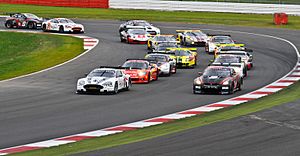
In sports car racing, production-derived versions of sports cars, also known as grand tourers (GTs), and purpose-built sports prototype cars compete within their respective classes on closed circuits. The premier championship series of sports car racing is the FIA World Endurance Championship. The main series for GT car racing is the FIA GT1 World Championship. There is also the FIA GT3 European Championship as well as the less powerful GT4 European Cup. Previously, an intermediate FIA GT2 European Championship existed, but the FIA dropped it to cut costs. Other major GT championships include the Japanese Super GT championship and the International GT Open for GT2 and GT3 cars. There are also national GT championships using mainly GT3 and GT4 cars featuring professional and amateur drivers alike.
Sports prototypes, unlike GT cars, do not rely on road-legal cars as a base. They are closed-wheel and often closed-cockpit purpose-built race cars intended mainly for endurance racing. They have much lower weight and more down force compared to GT cars, making them much faster. They are raced in the 24 hours of Le Mans (held annually since 1923) and in the (European) Le Mans series, Asian Le Mans Series and the WeatherTech SportsCar Championship. These cars are referred to as LMP (Le Mans prototype) cars with LMP1 being run mainly by manufacturers and the slightly less powerful LMP2 cars run by privateer teams. All three Le Mans Series run GT cars in addition to Le Mans Prototypes; these cars have different restrictions than the FIA GT cars.
Another prototype and GT racing championship exists in the United States; the Grand-Am, which began in 2000, sanctions its own endurance series, the Rolex Sports Car Series, which consists of slower and lower-cost race cars compared to LMP and FIA GT cars. The Rolex Sports Car Series and American Le Mans Series announced a merger between the two series forming the WeatherTech SportsCar Championship starting in 2014.
These races are often conducted over long distances, at least 1,000 km (621 mi), and cars are driven by teams of two or more drivers, switching every few hours. Due to the performance difference between production-based sports cars and purpose-built sports prototypes, one race usually involves several racing classes, each fighting for their own championship.
Famous sports car races include the 24 Hours of Le Mans, the Rolex 24 at Daytona, 24 Hours of Spa-Franchorchamps, the 12 Hours of Sebring, the 6 Hours of Watkins Glen, and the 1,000-mile (1,600 km) Petit Le Mans at Road Atlanta. There is also the 24 Hours of the Nürburgring on the infamous Nordschleife track and the Dubai 24 Hour, which is aimed at GT3 and below cars with a mixture of professional and pro-am drivers.
Production-car racing
Production-car racing, otherwise known as "showroom stock" in the US, is an economical and rules-restricted version of touring-car racing, mainly used to restrict costs. Numerous production racing categories are based on particular makes of cars.
Most series follow the Group N regulation with a few exceptions. There are several different series that are run all over the world, most notably, Japan's Super Taikyu and IMSA's Firehawk Series, which ran in the 1980s and 1990s all over the United States.
One-make racing
One-make, or single marque, championships often employ production-based cars from a single manufacturer or even a single model from a manufacturer's range. There are numerous notable one-make formulae from various countries and regions, some of which – such as the Porsche Supercup and, previously, IROC – have fostered many distinct national championships. Single marque series are often found at club level, to which the production-based cars, limited modifications, and close parity in performance are very well suited. Some of the better-known single-make series are the Mini 7 Championship (Europe's longest-running one make championship), the Radical European Masters, John Cooper Mini Challenge, Clio Cup, Ginettas, Caterhams, BMWs, and MX5s. There are also single-chassis single seater formulae, such as Formula Renault and Formula BMW, usually as "feeder" series for "senior" race formula (in the fashion of farm teams).
Stock car racing
In North America, stock car racing is the most popular form of auto racing. Primarily raced on oval tracks, stock cars vaguely resemble production cars, but are in fact purpose-built racing machines that are built to tight specifications and also called Silhouette racing cars.
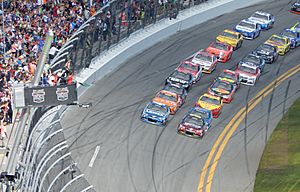
The largest stock car racing governing body is NASCAR (National Association for Stock Car Auto Racing). NASCAR's premier series is the Monster Energy Cup Series, its most famous races being the Daytona 500, the Southern 500, the Coca-Cola 600, and the Brickyard 400. NASCAR also runs several feeder series, including the Xfinity Series and Camping World Truck Series (a pickup truck racing series). The series conduct races across the entire continental United States. The NASCAR Pinty's Series conducts races across Canada and the NASCAR PEAK Mexico Series conducts races across Mexico.
NASCAR also governs several smaller regional series, such as the Whelen Modified Tour. Modified cars are best described as open-wheel cars. Modified cars have no parts related to the stock vehicle for which they are named after. A number of modified cars display a "manufacturer's" logo and "vehicle name", yet use components produced by another automobile manufacturer.
There are also other stock car governing bodies, most notably the Automobile Racing Club of America (ARCA).
In the UK, British Stock car racing is also referred to as "Short Circuit Racing". This takes place on shale or tarmac tracks – usually around 1/4 mile long. The governing bodies for the sport are the Oval Racing Council (ORC) and BriSCA. Both bodies are made up of individual stadium promoters. There are around 35 tracks in the UK and upwards of 7000 active drivers. The sport is split into three basic divisions – distinguished by the rules regarding car contact during racing. The most famous championship is the BriSCA F1 Stock Cars. Full-contact formulas include Bangers, Bombers and Rookie Bangers – and racing features Demolitions Derbies, Figure of Eight racing and Oval Racing.
Semi Contact Formulas include BriSCA F1, F2 and Superstox – where bumpers are used tactically.
Non-contact formulas include National Hot Rods, Stock Rods and Lightning Rods.
UK Stock car racing started in the 1950s and grew rapidly through the 1960s and 1970s.
Rallying
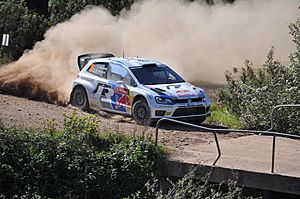
Rallying at international and most national championship levels involves two classes of homologated road-legal production-based cars; Group N production cars and more modified Group A cars. Cars compete on closed public roads or off-road areas on a point-to-point format where participants and their co-drivers "rally" to a set of points, leaving in regular intervals from start points. A rally is typically conducted over a number of "special stages" on any terrain, which entrants are often allowed to scout beforehand at reduced speeds compiling detailed shorthand descriptions of the track or road as they go. These detailed descriptions are known as pace notes. During the actual rally, the co-driver reads the pace notes aloud (using an in-helmet intercom system) to the driver, enabling them to complete each stage as quickly as possible. Competition is based on lowest total elapsed time over the course of an event's special stages, including penalties.
The top series is the World Rally Championship (WRC), first contested in 1973, but there are also regional championships, and many countries have their own national championships. Some famous rallies include the Monte Carlo Rally, Rally Argentina, Rally Finland and Rally GB. Another famous event (actually best described as a rally raid) is the Paris-Dakar Rally, conceived in 1978. There are also many smaller, club level, categories of rallies, which are popular with amateurs, making up the "grass roots" of motor sports. Cars at this level may not comply fully with the requirements of group A or group N homologation. Other major rally events include the British Rally Championship, Intercontinental Rally Challenge, African Rally Championship, Asia-Pacific Rally Championship and endurance rally events like the Dakar Rally.
The Targa Tasmania, held on the Australian island state of Tasmania and run annually since 1992, takes its name from the Targa Florio, a former motoring event held on the island of Sicily. The competition concept is drawn directly from the best features of the Mille Miglia, the Coupe des Alpes and the Tour de Corse. Similarly named events around the world include the Targa Newfoundland based in Canada, Targa West based in Western Australia, Targa New Zealand and other smaller events.
Drag racing
In drag racing, the objective is to complete a given straight-line distance, from a standing start, ahead of a vehicle in a parallel lane. This distance is traditionally 1⁄4 mile (400 m), though 1⁄8 mile (200 m) has become popular since the 1990s. The vehicles may or may not be given the signal to start at the same time, depending on the class of racing. Vehicles range from the everyday car to the purpose-built dragster. Speeds and elapsed time differ from class to class. Average street cars cover the ¼ mile in 12 to 16 seconds, whereas a top fuel dragster takes 4.5 seconds or less, reaching speeds of up to 530 km/h (329 mph). Drag racing was organized as a sport by Wally Parks in the early 1950s through the NHRA (National Hot Rod Association). The NHRA was formed to discourage street racing.
When launching, a top fuel dragster will accelerate at 3.4 g (33 m/s²), and when braking parachutes are deployed the deceleration is 4 g (39 m/s²), more than the Space Shuttle experiences. A top fuel car can be heard over 8 miles (13 km) away and can generate a reading from 1.5 to 3.9 on the Richter scale.
Drag racing is two cars head-to-head, the winner proceeding to the next round. Professional classes are all first to the finish line wins. Sportsman racing is handicapped (slower car getting a head start) using an index (a lowest e.t. allowed), and cars running under (quicker than) their index "break out" and lose. The slowest cars, bracket racers, are also handicapped, but rather than an index, they use a dial-in.
Off-road racing
In off-road racing, various classes of specially modified vehicles, including cars, compete in races through off-road environments. In North America these races often take place in the desert, such as the famous Baja 1000. Another format for off-road racing happens on closed-course short course tracks such as Crandon International Off-Road Raceway. In the 1980s and 1990s, short course was extended to racing inside stadiums in the Mickey Thompson Entertainment Group; this format was revived by Robby Gordon in 2013 with his Speed Energy Formula Off-Road series.
In Europe, "offroad" refers to events such as autocross or rallycross, while desert races and rally-raids such as the Paris-Dakar, Master Rallye or European "bajas" are called "cross-country rallies."
Kart racing
The modern kart was invented by Art Ingels, a fabricator at the Indianapolis-car manufacturer Kurtis-Kraft, in Southern California in 1956. Ingels took a small chainsaw engine and mounted it to a simple tube-frame chassis weighing less than 100 lb. Ingels, and everyone else who drove the kart, were startled at its performance capabilities. The sport soon blossomed in Southern California, and quickly spread around the world. Although often seen as the entry point for serious racers into the sport, kart racing, or karting, can be an economical way for amateurs to try racing and is also a fully fledged international sport in its own right. A large proportion of professional racing drivers began in karts, often from a very young age, such as Michael Schumacher and Fernando Alonso. Several former motorcycle champions have also taken up the sport, notably Wayne Rainey, who was paralysed in a racing accident and now races a hand-controlled kart. As one of the cheapest ways to race, karting is seeing its popularity grow worldwide.
Despite their diminutive size, karting's most powerful class, superkart, can have a power-to-weight ratio of 440 hp/tonne.
Related pages
Images for kids
-
The 2017 Formula Student electric race-car of the Delft University of Technology
-
Mazda Raceway Laguna Seca, Monterey, 2008
See also
 In Spanish: Automovilismo para niños
In Spanish: Automovilismo para niños


